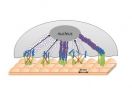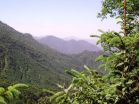(Press-News.org) A new method to make better use of vast amounts of data related to global geography, population and climate may help determine the relative importance of population increases vs. climate change.
While several recent studies suggest that much of the world is likely to experience freshwater shortages as the population increases and temperatures rise, determining the relative impact of each has been difficult. An Oak Ridge National Laboratory paper published in Computers & Geosciences outlines a process that might help.
"Our work establishes a new method to couple geographic information system data with global climate outputs and statistical analysis," said ORNL's Esther Parish, lead author. Using this technique, researchers can now conduct assessments that will provide information critical to policymakers and stakeholders.
"Our tool provides a simple method to integrate disparate climate and population data sources and develop preliminary per capita water availability projections at a global scale," said Parish, a member of the Department of Energy laboratory's Environmental Sciences Division.
Parish and co-authors Evan Kodra, Karsten Steinhaeuser and Auroop Ganguly began working on this approach at ORNL in the summer of 2009. At that time, it was unusual to integrate population, climate and water data into one model. Although just a first step, the toolkit, which has been made freely available, may be further developed for more involved analysis.
While results of the study point to areas potentially vulnerable to water shortages, Parish cautioned that this set of calculations is based on just one set of ensembles from one climate model with static population growth rates applied on a per country basis.
By water stress, researchers are referring to per capita freshwater availability of less than 450,000 gallons per person per year, but the ways society chooses to store and allocate water will determine whether an actual shortage exits. For example, water can be allocated for industry, agriculture or residential use, or any combination of the three.
For this study, the team used ORNL's high-resolution Global LandScan population distribution dataset in combination with population growth projections from the Intergovernmental Panel on Climate Change. This allowed them to estimate changes in freshwater demand by 2025, 2050 and 2100. The researchers also used the Community Climate System Model 3 to estimate future freshwater availability during those same time periods. Researchers then combined freshwater supply and demand projections to yield estimates of per capita water availability around the world.
Given the number of variables, the process can quickly become unwieldy.
"Analyzing the interrelationship between human populations and water availability is greatly complicated by the uncertainties associated with climate change projections and population storylines," said Parish, who added that for this exploratory study population growth appears to have a greater impact than temperature.
To test the new tool, Parish and colleagues plugged in four IPCC greenhouse gas emissions scenarios – from low to high – along with global population projections to arrive at different potential scenarios. None paint a promising picture for freshwater availability.
The study suggests that by 2100, 56 to 75 percent of the world's population could be vulnerable to significant freshwater security threats. In areas like the Great Lakes region, freshwater may be easier to replenish than portions of Florida and the Southwest, but people in most areas of the country will face challenges.
"The worst case combination of per capita freshwater availability indicate that many major U.S. cities may experience some degree of water stress by the year 2100," Parish said.
In addition, the feedback between population shifts and water resources scarcity may exacerbate the situation. Thus, as pointed out in other recent studies, the projected water scarcity in parts of Central and South America may have ramifications for population movement and hence water scarcity in the United States.
"While we have not considered migration as part of this paper, these are precisely the directions we believe require further research," Ganguly said.
The researchers noted that while this paper outlines a proof of concept that lends some preliminary insight to the relative importance of climate change vs. population, output from multiple climate models must be incorporated in future research.
"By investigating multiple models, we may be able to quantify -- or at least qualify -- uncertainty in how different climate change scenarios could affect water availability," Parish said. "Given that population growth is likely to be an even bigger factor in water availability than climate change, it will also be critical to reassess areas of concern with regional- or state-level population growth scenarios."
Ganguly added: "Our understanding of multiple stressors on natural resources as well as dynamically coupled natural and human systems is critical to address emerging concerns like urban sustainability."
###Kodra and Ganguly, both formerly of ORNL, are employed by Northeastern University while Steinhaeuser, also formerly of ORNL, is employed by the University of Minnesota.
Funding for this project was provided initially by the Laboratory Directed Research and Development program and, later, by the National Science Foundation.
UT-Battelle manages ORNL for the Office of Science. The Office of Science is the single largest supporter of basic research in the physical sciences in the United States and is working to address some of the most pressing challenges of our time. For more information, please visit http://science.energy.gov/
New ORNL tool developed to assess global freshwater stress
2012-03-26
ELSE PRESS RELEASES FROM THIS DATE:
'Bed-of-nails' breast implant deters cancer cells
2012-03-26
PROVIDENCE, R.I. [Brown University] -- One in eight women in the United States will develop breast cancer. Of those, many will undergo surgery to remove the tumor and will require some kind of breast reconstruction afterward, often involving implants. Cancer is an elusive target, though, and malignant cells return for as many as one-fifth of women originally diagnosed, according to the American Cancer Society.
Would it be possible to engineer implant materials that might drive down that rate of relapse? Brown University biomedical scientists report some promising advances. ...
Huge hamsters and pint-sized porcupines thrive on islands
2012-03-26
DURHAM, N.C. -- From miniature elephants to monster mice, and even Hobbit-sized humans, size changes in island animals are well-known to science. Biologists have long believed that large animals evolving on islands tend to get smaller, while small animals tend to get bigger, a generalization they call "the island rule."
A new study by researchers at Duke University and the National Evolutionary Synthesis Center in Durham, NC puts that old idea to the test in island and mainland rodents.
"Some of the size changes observed in island animals are pretty dramatic," said ...
Researchers unveil robot jellyfish built on nanotechnology
2012-03-26
Researchers at The University of Texas at Dallas and Virginia Tech have created an undersea vehicle inspired by the common jellyfish that runs on renewable energy and could be used in ocean rescue and surveillance missions.
In a study published this week in Smart Materials and Structures, scientists created a robotic jellyfish, dubbed Robojelly, that feeds off hydrogen and oxygen gases found in water.
"We've created an underwater robot that doesn't need batteries or electricity," said Dr. Yonas Tadesse, assistant professor of mechanical engineering at UT Dallas and ...
Possible causes of sudden onset OCD in kids broadened
2012-03-26
Criteria for a broadened syndrome of acute onset obsessive compulsive disorder (OCD) have been proposed by a National Institutes of Health scientist and her colleagues. The syndrome, Pediatric Acute-onset Neuropsychiatric Syndrome (PANS), includes children and teens that suddenly develop on-again/off-again OCD symptoms or abnormal eating behaviors, along with other psychiatric symptoms – without any known cause.
PANS expands on Pediatric Autoimmune Neuropsychiatric Disorder Associated with Streptococcus (PANDAS), which is limited to a subset of cases traceable to ...
UN hits water target, but 1.8 billion people still drinking unsafe water, study shows
2012-03-26
Recent widespread news coverage heralded the success of a United Nations' goal of greatly improving access to safe drinking water around the world.
But while major progress has been made, a new study from the University of North Carolina at Chapel Hill indicates that far greater challenges persist than headline statistics suggested.
Earlier this month (March 6), UNICEF and the World Health Organization issued a report stating that the world had met the U.N.'s Millennium Development Goal target of halving the proportion of people without access to safe drinking water, ...
Mountaintop blasting to mine the sky with the Giant Magellan Telescope
2012-03-26
Pasadena, CA--Astronomers have begun to blast 3 million cubic feet of rock from a mountaintop in the Chilean Andes to make room for what will be the world's largest telescope when completed near the end of the decade. The telescope will be located at the Carnegie Institution's Las Campanas Observatory—one of the world's premier astronomical sites, known for its pristine conditions and clear, dark skies. Over the next few months, more than 70 controlled blasts will break up the rock while leaving a solid bedrock foundation for the telescope and its precision scientific instruments.
The ...
Learning best when you rest: Sleeping after processing new info most effective, new study shows
2012-03-26
Nodding off in class may not be such a bad idea after all. New research from the University of Notre Dame shows that going to sleep shortly after learning new material is most beneficial for recall,
Titled "Memory for Semantically Related and Unrelated Declarative Information:
The Benefit of Sleep, the Cost of Wake," the study was published March 22 in PLOS One.
Notre Dame Psychologist Jessica Payne and colleagues studied 207 students who habitually slept for at least six hours per night. Participants were randomly assigned to study declarative, semantically ...
Researchers discover why humans began walking upright
2012-03-26
WASHINGTON—Most of us walk and carry items in our hands every day. These are seemingly simple activities that the majority of us don't question. But an international team of researchers, including Brian Richmond at the George Washington University, have discovered that human bipedalism, or walking upright, may have originated millions of years ago as an adaptation to carrying scarce, high-quality resources. This latest research was published in this month's "Current Biology."
The team of researchers from the U.S., England, Japan and Portugal investigated the behavior ...
Researchers develop new technique to assess diversity of plant species from afar
2012-03-26
EAST LANSING, Mich. --- By analyzing vegetation information collected by satellites over time instead of for just one day, scientists in the Michigan State University Center for Systems Integration and Sustainability (CSIS) have developed a novel procedure to assess the composition of plant species in an area.
Researchers long have used multi-spectral images (which include radiation outside human perception, such as infrared) and other remotely sensed data to create maps of vegetation around the globe. But seasonal changes in vegetation can limit the usefulness of these ...
Embryonic stem cells shift metabolism in cancer-like way upon implanting in uterus
2012-03-26
Shortly after a mouse embryo starts to form, some of its stem cells undergo a dramatic metabolic shift to enter the next stage of development, Seattle researchers report today. These stem cells start using and producing energy like cancer cells.
This discovery is published today in EMBO, the European Molecular Biology Organization journal.
"These findings not only have implications for stem cell research and the study of how embryos grow and take shape, but also for cancer therapy," said the senior author of the study, Dr. Hannele Ruohola-Baker, University of Washington ...



